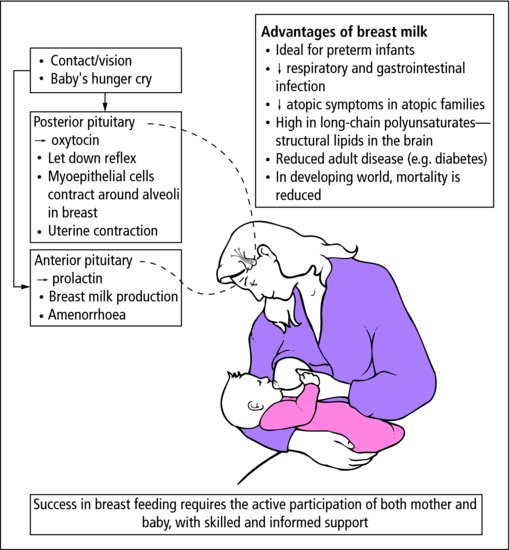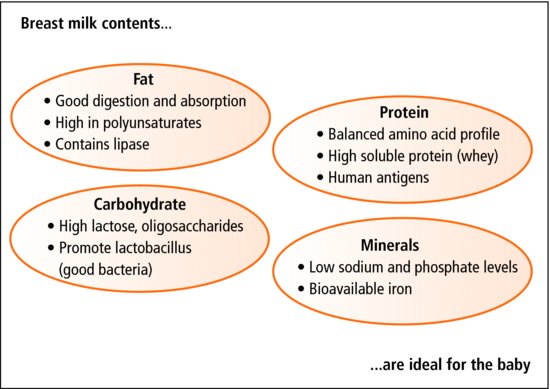12
Nutrition
Chapter map
Infant and child nutrition is the foundation stone of healthy development. Worldwide, the most important problem is malnutrition. In industrialized societies, the main problems are eating unwisely or eating too much. In clinical practice, nutritional care is central to the management of all chronic diseases.
Nutrition is particularly important in the first year of life, when the infant is entirely dependent on his carers to feed him. Babies treble their birth weight in the first year of life; to treble it again takes 10 years. In fact, 65% of total postnatal brain growth takes place in the first year of life. Malnutrition may permanently disrupt physical and mental development.
12.1.5 Iron and vitamin supplements
12.2 Nutrition of toddlers and school children
12.5 Nutrition in chronic disease
 PRACTICE POINT
PRACTICE POINT12.1 Infant nutrition
 Average requirements in infancy
Average requirements in infancy| Water | 150 mL/kg/day |
| Calories | 110 kcal/kg/day |
12.1.1 Milk
Milk is a rich source of energy, proteins and minerals. It is the sole source of nutrition for the first months, and provides an essential part of energy, protein and calcium intake in pre-school children. Cow’s milk has a high mineral content and osmolality. Infant formula feeds are modified to be more like breast milk.
Unmodified cow’s milk should not be given in the first year: breast or formula feeding is recommended to 12 months, alongside weaning foods from 6 months. As a rule, children under 5 years should drink whole milk, and not fat-reduced.
12.1.2 Breastfeeding
 PRACTICE POINT
PRACTICE POINT- Antenatal advice
- Put baby to breast soon after delivery
- Demand feeding
- Comfortable position for mother and baby
- Ensure good ‘attachment’
- No food or drink but breast milk (unless medically indicated)
- Avoid dummies and teats
- Professional and family support and encouragement
- Promote popular awareness and support.
Women should receive information, advice and encouragement (Figure 12.1). Nobody wants to see unwilling mothers browbeaten into breastfeeding, but there is a happy medium between that and the indifference shown by many doctors and nurses.
Breast milk is nutritionally ideal for the term infant (Figure 12.2). Milk proteins are easily soluble (whey) or tend to curdle or precipitate (casein). Breast milk is whey dominant (70%). It is free, readily available and convenient. Breastfeeding, even for a few months, gives an infant an excellent start to life. Protection from infection is important for survival in developing countries.
 RESOURCE
RESOURCE- www.nhs.uk – search ‘pregnancy and baby’, click any link, then choose ‘Your newborn’ from the main menu for resources on breast and bottle feeding, with useful links. Alternatively search ‘breastfeeding’ for other resources including a ‘video wall’ with a good animation.
- http://newborns.stanford.edu/breastfeeding – a useful set of resources on breastfeeding from Stanford School of Medicine USA.
- Sterile feed
- Maternal antibody (IgA)
- Lactoferrin
- Lysozyme
- Promotes colonization with lactobacilli and bifidobacter.
Breast-fed babies are usually fed on demand but may be fed by the clock. To establish lactation, most recommend frequent demand feeding: after a feed the infant is allowed to rest, and the next feed is given when the infant wakes and appears hungry. Crying does not necessarily mean hunger: sleep does not necessarily mean satiation. Breastfeeding is a highly satisfying experience for the mother and infant. Seldom is there true failure of lactation. In the UK, rates have been rising but there is room for improvement: 80% of all mothers begin to breastfeed, 55% continue some breastfeeding at 6 weeks, and 34% at 6 months. Variation in rates is large: almost 90% of social class I mothers choose breastfeeding. In the UK, breastfeeding usually stops at 4–9 months; in the developing world, 2 years is the rule. There is, however, no evidence to suggest that bottle-fed European babies are either nutritionally or emotionally deprived.
Many drugs are excreted in breast milk, but maternal medication is rarely a contraindication to breastfeeding. The British National Formulary offers advice on most drugs. Breastfeeding is contraindicated with high-dose steroids, cytotoxic and immunosuppressive agents. Breast milk contains very little vitamin K (Section 7.3). Viral transmission means that breastfeeding is contraindicated in known maternal HIV infection in developed countries (but not in the developing world, where the benefits still outweigh the small risk). ‘Breast milk jaundice’ is not a reason to stop (Section 8.4.2.1, p. 77).
 RESOURCE
RESOURCE- Child and Maternal Health Intelligence Network: http://atlas.chimat.org.uk – choose ‘Breastfeeding profiles’ for rates of breastfeeding by UK area
- UNICEF: www.unicef.org.uk/babyfriendly gives information on the UNICEF/WHO ‘Baby Friendly Hospital’ initiative, which promotes breastfeeding worldwide.
12.1.3 Bottle feeding
Formula feeds are available in two forms: whey dominant (60% whey) like breast milk and casein dominant (30% whey). The former is more akin to breast milk and should be first choice. Each of the four UK milk manufacturers makes two milks so that a mother can change milks without changing company. There are no major advantages to different manufacturers’ milks, and parents should be dissuaded from constantly changing milk. Follow-on formula should not be used before 6 months. Their use after that age is popular but not necessary. Attention to detail in making up the feed is essential. Extra scoops, heaped scoops, packed scoops or additional cereal should be avoided. They add calories which encourage obesity, and extra solutes which cause thirst, irritability and hypernatraemia. It is conventional to warm feeds to approximately body temperature, but this is not always needed.
- Take 4 oz of cooled boiled tap water
- Fill scoop without compressing powder
- Scrape scoop level with clean knife
- Add four scoops of powder
- Dissolve, allow to cool to about 37 °C
- May be refrigerated
- Only rewarm once.






